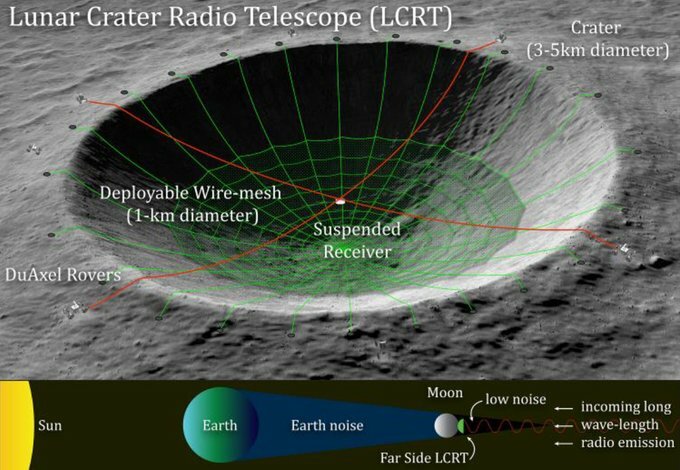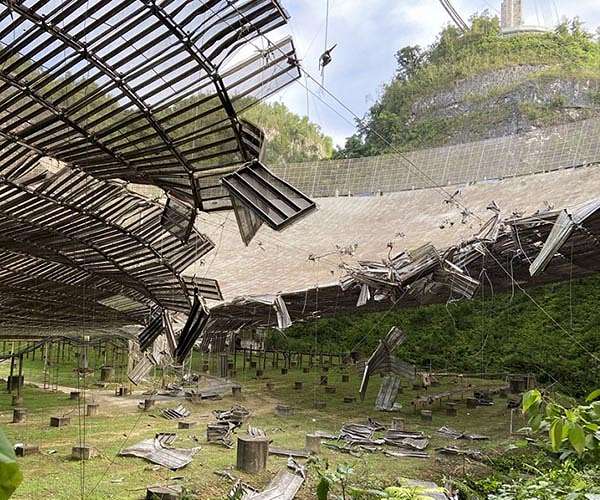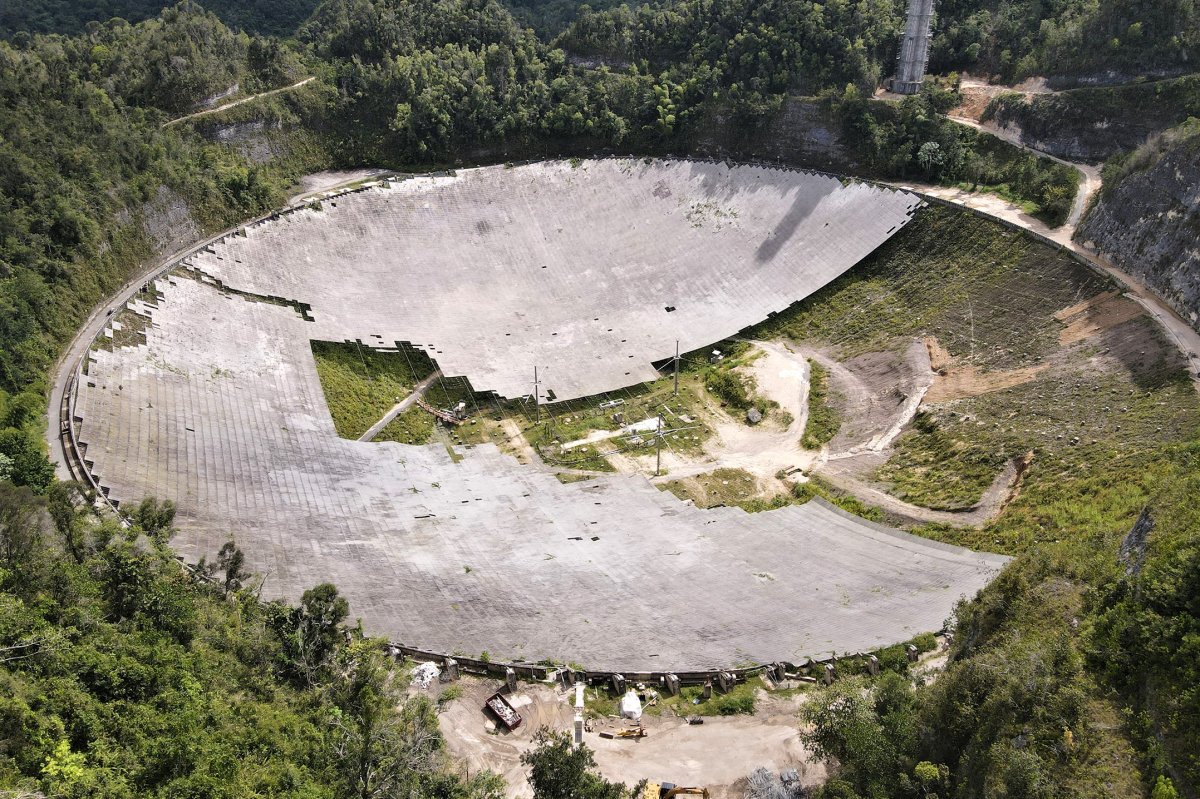You are using an out of date browser. It may not display this or other websites correctly.
You should upgrade or use an alternative browser.
You should upgrade or use an alternative browser.
Snapped Cable Damages Arecibo observatory radio telescope:
- Thread starter Flyaway
- Start date
martinbayer
ACCESS: Top Secret
- Joined
- 6 January 2009
- Messages
- 3,398
- Reaction score
- 3,906
I think as a large infrastructure project in the public interest it is actually an excellent candidate to build back better.
Last edited:
- Joined
- 9 October 2009
- Messages
- 21,976
- Reaction score
- 13,638
I think as a large infrastructure project in the public interest it is actually an excellent candidate to build back better.
Alas, in the current era though...
Here are a couple more interesting videos:
- Joined
- 21 January 2015
- Messages
- 12,156
- Reaction score
- 16,372
FighterJock
ACCESS: Above Top Secret
- Joined
- 29 October 2007
- Messages
- 5,609
- Reaction score
- 5,941
I should think so too, if it was not for the years of no (or little) funding from the NSF we would not be in this mess.
- Joined
- 3 June 2011
- Messages
- 18,339
- Reaction score
- 12,242
Massimo on Twitter: "NASA recently gave out a new round of grants for its favourite up and coming innovative space projects. One of which is a plan to fit a 1 km radio telescope inside a crater on the far side of the Moon, the largest radio telescope in the Solar System https://t.co/3NEsqpwoER https://t.co/MXrqZy8xOO" / Twitter


- Joined
- 21 January 2015
- Messages
- 12,156
- Reaction score
- 16,372
If it is not somehow proofed against meteorites, what will be the life expectancy of a 1km-wide structure?
Probably a very long time. The structure would be akin to a wire mesh net; much of it's area would be open space that micrometeorites would simply pass through. The rest could be hit and torn to bits with little actual damage to the dishes functionality.
Sure. But the point remains: the surface of a radio dish is going to be many orders of magnitude less fussy than an optical scope. And the lightweight, relatively fragile nature of the material, whether it's a woven net, or sheets of foil, or etched foil, actually works in your favor when dealing with a lunar environment. On earth, wind can tear a really lightweight mesh. On the moon, you can blast it 24/7 with micometeors. Each one will punch a hole not much bigger than the impactor, with little effect on the surrounding reflector material. Punch a billion microscopic holes it it, it just won't matter. The total area taken out in a century of normal bombardment would be a vanishingly small fraction of the total and would possibly not even be noticed. Shoot, you could probably have spiderbots crawling around it non-stop repairing little dings, with a one-year rotation period.that depends on the frequencies you want to operate at. At 1.42 GHz (21 cm, hydrogen wavelength) the mesh can be ~ 5x5 cm. Higher frequencies need a smaller mesh.
Last edited:
A comprehensive narrative of the events focused on engineering challenges:
 www.sciencemag.org
www.sciencemag.org
Science | AAAS
Last edited:
- Joined
- 9 October 2009
- Messages
- 21,976
- Reaction score
- 13,638
- Joined
- 21 January 2015
- Messages
- 12,156
- Reaction score
- 16,372
FighterJock
ACCESS: Above Top Secret
- Joined
- 29 October 2007
- Messages
- 5,609
- Reaction score
- 5,941
Thanks for posting the link Flyaway, let's hope that The Next Generation Arecibo Telescope gets the necessary funding from the NSF so that it can be built.
- Joined
- 9 October 2009
- Messages
- 21,976
- Reaction score
- 13,638
- Joined
- 21 January 2015
- Messages
- 12,156
- Reaction score
- 16,372
A report by the National Science Foundation estimates it will cost up to $50 million to clean up the damage from the collapsed Arecibo radio telescope, but that it is still too soon to determine whether or how to rebuild the famous observatory.
NSF added that it is planning a “community workshop” in April to discuss potential options for the site. “The development costs of potential projects coming out of this stakeholder engagement are unknown,” it stated.

NSF report estimates Arecibo cleanup cost at up to $50 million
A report by the National Science Foundation estimates it will cost up to $50 million to clean up the damage from the collapsed Arecibo radio telescope, but that it is still too soon to determine wh…
 spacenews.com
spacenews.com
FighterJock
ACCESS: Above Top Secret
- Joined
- 29 October 2007
- Messages
- 5,609
- Reaction score
- 5,941
A report by the National Science Foundation estimates it will cost up to $50 million to clean up the damage from the collapsed Arecibo radio telescope, but that it is still too soon to determine whether or how to rebuild the famous observatory.
NSF added that it is planning a “community workshop” in April to discuss potential options for the site. “The development costs of potential projects coming out of this stakeholder engagement are unknown,” it stated.

NSF report estimates Arecibo cleanup cost at up to $50 million
A report by the National Science Foundation estimates it will cost up to $50 million to clean up the damage from the collapsed Arecibo radio telescope, but that it is still too soon to determine wh…spacenews.com
Fifty million dollars? Just to clean up the mess left by the Arecibo collapse, the more I read about the problems at Arecibo the more angry I get.
- Joined
- 27 September 2006
- Messages
- 6,417
- Reaction score
- 6,819
Would be interested to know a bit more about the Chinese one. This may be an area where competition between the great powers could be constructive.China built a bigger one so it's not like the world lost capability.In a sh te year another bit of bad news
The loss of the Aracibo array is another blow to our modern world in the face of nature.
Legendary Arecibo telescope will close forever — scientists are reeling
New satellite image reveals the damage that shut down the facility, ending an era in astronomical observation.www.nature.com
The Chinese large fixed-dish telescope is called FAST (Five-hundred-meter Aperture Spherical radio Telescope).
Its main advantage over Arecibo is more flexible pointing. The effective collecting area is up to 300 m in diameter: at any location of the receiver array, only a section of the primary dish is in view. Unlike Arecibo, the primary dish panels are adjustable to make a more accurate parabola.
Its main disadvantage is the lack of radar. Arecibo had the most powerful planetary radar system in the world.
Its main advantage over Arecibo is more flexible pointing. The effective collecting area is up to 300 m in diameter: at any location of the receiver array, only a section of the primary dish is in view. Unlike Arecibo, the primary dish panels are adjustable to make a more accurate parabola.
Its main disadvantage is the lack of radar. Arecibo had the most powerful planetary radar system in the world.
- Joined
- 9 October 2009
- Messages
- 21,976
- Reaction score
- 13,638

Arecibo telescope collapse may complicate NASA asteroid mission
Washington DC (UPI) Mar 12, 2021 - The destructive collapse in December of the world's most powerful radar telescope, Arecibo Observatory in Puerto Rico, will make some observations of an upcoming asteroid mission difficult, according to NASA.
www.spacedaily.com
- Joined
- 21 January 2015
- Messages
- 12,156
- Reaction score
- 16,372
View: https://twitter.com/spacewillinfo/status/1371702604057649152
#GF-2 satellite image collected on March 13 shows the cleanup of iconic #AcreciboObservatory in #PuertoRico, which collapsed last December. The cleaning up could cost 30-50 million USD, according to the National Science Foundation, USA. #infrastructuremonitoring
FighterJock
ACCESS: Above Top Secret
- Joined
- 29 October 2007
- Messages
- 5,609
- Reaction score
- 5,941
View: https://twitter.com/spacewillinfo/status/1371702604057649152
#GF-2 satellite image collected on March 13 shows the cleanup of iconic #AcreciboObservatory in #PuertoRico, which collapsed last December. The cleaning up could cost 30-50 million USD, according to the National Science Foundation, USA. #infrastructuremonitoring
So what now, if it costs 30-50 million dollars to clean up the mess left by the Arecibo collapse then there is little hope of the NSF designing and building an Arecibo 2.
- Joined
- 9 October 2009
- Messages
- 21,976
- Reaction score
- 13,638
- Joined
- 21 January 2015
- Messages
- 12,156
- Reaction score
- 16,372
The famous Arecibo Observatory in Puerto Rico, once home to the world's most powerful radio telescope, has reopened to visitors more than a year after the giant facility collapsed.
The visitor center and observation deck are now open to visitors who make reservations in advance. From the outdoor deck, visitors can see the valley and remaining reflective dish -- 1,000 feet in diameter.

Arecibo Observatory reopens visitor center after telescope collapse - UPI.com
The famous Arecibo Observatory in Puerto Rico, once home to the world's most powerful radio telescope, has reopened to visitors more than a year after the giant facility collapsed.
 www.upi.com
www.upi.com
- Joined
- 21 January 2015
- Messages
- 12,156
- Reaction score
- 16,372
Local media in Puerto Rico are reporting today that NSF had a last-minute virtual meeting with staff at the observatory and announced that facilities will be closed by September 30, 2023 after a “transformation” to become a science education center. They were also told there would be a meeting with details on Friday and that NSF staff would be visiting the island this month.
There are still some instruments on-site (12 meter antenna, project PRISMA, and LIDAR research), but what will happen to these has apparently not been discussed.
Source (in Spanish) : https://teleonce.com/noticias/local...rvatorio-de-arecibo-para-septiembre-del-2023/
- Joined
- 9 October 2009
- Messages
- 21,976
- Reaction score
- 13,638

US Opts To Not Rebuild Renowned Puerto Rico Telescope - Slashdot
The National Science Foundation announced Thursday that it will not rebuild a renowned radio telescope in Puerto Rico, which was one of the world's largest until it collapsed nearly two years ago. The Associated Press reports: Instead, the agency issued a solicitation for the creation of a $5...
tech.slashdot.org
FighterJock
ACCESS: Above Top Secret
- Joined
- 29 October 2007
- Messages
- 5,609
- Reaction score
- 5,941

US Opts To Not Rebuild Renowned Puerto Rico Telescope - Slashdot
The National Science Foundation announced Thursday that it will not rebuild a renowned radio telescope in Puerto Rico, which was one of the world's largest until it collapsed nearly two years ago. The Associated Press reports: Instead, the agency issued a solicitation for the creation of a $5...tech.slashdot.org
That is well and truly sad news about the US not going to build a successor to the Arecibo radio telescope. An end of an era sadly.
- Joined
- 18 June 2009
- Messages
- 1,412
- Reaction score
- 2,494
Hanz2k
The truth is grey...
- Joined
- 17 February 2012
- Messages
- 155
- Reaction score
- 226
Why not to make Lunar telescope using remote vehicles. Just use minimum 6 of them to deploy/drag mesh from the center of the crater and receiver on telescopic mast that could be hang in a way that TV cameras over football field works. Then vehicles will be hook points, energy suppliers and retransmit stations. Something like this:
- Joined
- 21 January 2015
- Messages
- 12,156
- Reaction score
- 16,372
- Joined
- 21 January 2015
- Messages
- 12,156
- Reaction score
- 16,372
Failure and Collapse of the Arecibo Observatory Telescope Assessed by New Report

 gizmodo.com
gizmodo.com

Jaw-Dropping Report Reveals Causes of Arecibo Telescope Collapse
An investigation by the National Academies of Sciences, Engineering, and Medicine found Hurricane Maria worsened a slow decay of the Arecibo Observatory's support cables.
Last edited:
FighterJock
ACCESS: Above Top Secret
- Joined
- 29 October 2007
- Messages
- 5,609
- Reaction score
- 5,941
Tell us something that we do not already know about the failure and collapse of the Arecibo observatory, the whole thing makes my blood boil.
